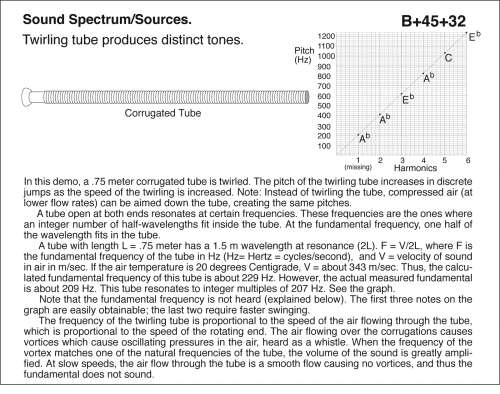Twirling Tube
Primary tabs
Twirling tube produces distinct tones. In this demo, a .75 meter corrugated tube is twirled. The pitch of the twirling tube increases in discrete jumps as the speed of the twirling is increased. Note: Instead of twirling the tube, compressed air (at lower flow rates) can be aimed down the tube, creating the same pitches. A tube open at both ends resonates at certain frequencies. These frequencies are the ones where an integer number of half-wavelengths fit inside the tube. At the fundamental frequency, one half of the wavelength fits in the tube. A tube with length L = .75 meter has a 1.5 m wavelength at resonance (2L). F = V/2L, where F is the fundamental frequency of the tube in Hz (Hz= Hertz = cycles/second), and V = velocity of sound in air in m/sec. If the air temperature is 20 degrees Centigrade, V = about 343 m/sec. Thus, the calculated fundamental frequency of this tube is about 229 Hz. However, the actual measured fundamental is about 209 Hz. This tube resonates to integer multiples of 207 Hz. See the graph. Note that the fundamental frequency is not heard (explained below). The first three notes on the graph are easily obtainable; the last two require faster swinging. The frequency of the twirling tube is proportional to the speed of the air flowing through the tube, which is proportional to the speed of the rotating end. The air flowing over the corrugations causes vortices which cause oscillating pressures in the air, heard as a whistle. When the frequency of the vortex matches one of the natural frequencies of the tube, the volume of the sound is greatly amplified. At slow speeds, the air flow through the tube is a smooth flow causing no vortices, and thus the fundamental does not sound.
UCB Index:
B+45+32
PIRA Index:
3D30.35
UCB Taxonomy:
PIRA Taxonomy:
Popularity:
- Log in to post comments

